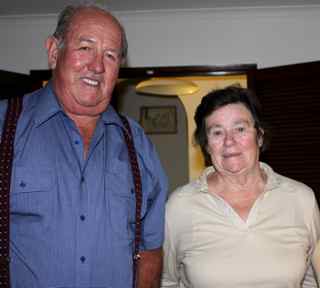 A police officer slams his foot in your door, then barges past you into your house, aggressively demands you and your wife provide identity proof…all over a minor incident never likely to go anywhere near a court. Two years down the track, and still no apology from the NSW Police. What stops them saying “Sorry”?
A police officer slams his foot in your door, then barges past you into your house, aggressively demands you and your wife provide identity proof…all over a minor incident never likely to go anywhere near a court. Two years down the track, and still no apology from the NSW Police. What stops them saying “Sorry”?
Two years, no police apology

A two-year-old complaint against police case, involving a retired couple, Bob and Ann Waldon of Moama on the Murray in NSW, is still not resolved because of NSW Police intransigence and seeming closing of ranks.
The NSW Police Force have refused to apologise over what is perceived by the Waldons as aggressive, intimidating and provocative behaviour by an officer.
Even using the legislative clauses quoted by police to condone the officer’s behaviour, some of his alleged behaviour would appear to not be compliant with those powers, even if an alleged “intimidation” incident he was supposedly investigating had been lodged as a formal complaint, and if he was an on-duty police officer carrying out his normal sworn duty.
The Waldons allege the officer literally used a foot-in-door technique to barge into their house and demand that Mrs Waldon, standing innocently by and traumatised in her own home, provide “proof” of identity, without reason, without explanation.
The Waldons’ nightmare stemmed from a police officer of the Moama Police Station attending their home on 24 April 2009. This was a week after an alleged minor incident, best summarised as Mr Waldon being on the receiving end of “road rage” gestures started by someone else, and responding. Given that it took a week for the police officer to darken the Waldons’ doorstep, it is highly unlikely that at any stage could the alleged Mr Waldon behaviour have been a serious offence.
Const X claimed to be on the Waldons’ verandah to make inquiries about the incident – an exchange of words between drivers of vehicles – involving Mr Waldon and a female neighbour from a couple of streets away, allegedly after a formally-lodged complaint to police by the neighbour. (However, NSW Police correspondence reveals that Const X made no report of his attendance at the Waldon home on the police system: he underwent formal “departmental counselling” for this failure to follow police procedure, both NSW Police and the NSW Ombudsman have reported…neither body found that any of Const X’s other behaviour was similarly inappropriate).
At the Waldons’ home, a conversation took place outside on the front verandah for about five minutes, after Waldon had introduced himself by name to the officer. When he believed the conversation was over, Waldon stepped back inside his house.
Immediately, the Waldons allege, Const X wedged his foot in the screen door, preventing it from closing, and demanded “proof of identity” from Mr Waldon. Const X did not provide Mr Waldon with the reason he was demanding proof of identity, nor did Const X warn Mr Waldon that he was required by law to comply with a request to self-identify.
Waldon said he had already told the officer who he was, when he greeted the officer on his first arrival. According to the Waldons’ account, Const X then wrenched open the foot-jammed door and physically forced his way past Mr Waldon into the Waldon house, past where Mrs Ann Waldon had been standing in the hallway, alarmed and frightened by what she alleges was the officer’s aggressive tone.
Waldon said Const X had no right to enter their home; Const X said he did. Waldon says he requested on a number of occasions that Const X leave, to no avail (the allegations have overtones of the Kuru v State of NSW case, eventually decided in the High Court in favour of Mr Kuru, who also repeatedly asked police to leave when an inquiry was effectively completed).
Const X’s manner was domineering and intimidating, the Waldons allege. In a bid to be rid of the police officer, Waldon showed his driver’s licence to him to satisfy the request for proof of identity. Const X subsequently demanded that Mrs Waldon also show proof of identity, again without providing a reason or any explanation: in considerable fear, she says, she hastened to get her driver’s licence, which she showed. For two years after the event, she was too traumatised by the police officer’s attitude and arrogance to drive in Moama, for fear of being pulled over and treated the same way by other police officers.
As Mrs Waldon could never have been an independent witness, it is not easily fathomed why “proof of identity” was demanded from her.
Bob and Ann Waldon, both 69 at the time of the incident, were severely alarmed while the incident was happening, and have suffered ongoing trauma ever since, particularly as they have had no satisfaction from repeated attempts to get the NSW Police to address the behaviour of the officer, and to apologise formally on behalf of the police department. A matter which could have been quickly resolved to the satisfaction of the Waldons has been exacerbated by the attitude of the NSW Police over two years, and counting. The trauma they suffer escalates as time goes by.
CLA’s position is that the Waldon case represents everyman/woman in NSW in establishing the boundaries of police powers over innocent NSW citizens in their own home. Unless the NSW Police see reason, the case may need to be decided in court to firmly establish police right of entry boundaries, and the boundaries on their demanding a person identify themselves and/or provide “proof” of identity (a separate issue from self-identifying). Does an innocent bystander wife, whose word could never be that of an independent witness, have any rights in her own home? (Later, Mrs Waldon’s corroborating story of the police officer’s behaviour was ignored by police, because she was not an independent witness).
No charge eventuated from the initial (‘road rage’) event: the whole original incident, allegedly the subject of a formal complaint, was a storm in a teacup. Hundreds of similar incidents happen on NSW roads every week without police being even being told about them.
Legal Aid NSW has refused to take up the Waldons’ case. While CLA understands it may operate to less than desired funding, we are puzzled as to its refusal to support a matter which has such widespread relevance to all citizens of NSW, and their privacy and security in their own homes.
NSW Police’s internal investigation of the Waldon complaint was completely unsatisfactory to Mr and Mrs Waldon, who were the “everyman” citizens of NSW out of the blue confronted by an allegedly domineering police officer acting in a manner which, whether designed to or not, frightened them.
Though the matter is rising two years old, Mr and Mrs Waldon see no reason why they should not continue to seek justice from the NSW Police for what they believe is an abuse of power. His original complaint asked that the officer be charged with behavioural offences.
CLA sees no reason why NSW citizens should be frightened to answer the door to NSW Police, because of the alleged behaviour of one officer. For a retired, older couple to continue to want to pursue a matter two years down the track, something significantly unpleasant must have happened to them.
ENDS
Below: copy of one of the early police response letters.
Note that even the NSW Police letter headlines the case as: “Inappropriate Behaviour of NSW Police”…not “Alleged Inappropriate Behaviour…” .
The police letter says “no departmental processes will be instigated”…but then, incongruously, says that “departmental counselling” has been undertaken. (Departmental counselling is apparently not a departmental process, in police-speak).
It is surprising – at the very least – that there was “departmental counsellling” of the officer in question apparently for not logging details of his actions in the police computer system.
Because the officer allegedly failed to log details of his actions, there is some doubt whether there ever was an official complaint to police in the first place on which the officer could lodge his actions on the day in question, and/or or whether the officer was officially on duty at the time of his confronting the Waldons.
It has not been unknown in the past for on or off-duty police in uniform to attempt to “put the frighteners on” citizens on behalf of male or female friends. CLA does not allege that this happened in this case: we do not know what happened. Mr Waldon has lodged an FOI request to try to find out the basic facts about the matter, as recorded by police.
The whole matter smacks of police ex-post facto justification: police can nearly always justify an officer’s behaviour by scouring their legislation to find a clause or two that suits the case they want to make out. But equally, citizens can scour the same laws, and almost inevitably find a clause or two of mandatory behaviour that the police officer omitted to undertake. That would appear to be the case here.
But the matter should be resolved away from legalities. The NSW Police should apologise at least for the fear and trauma inflicted on Mrs Waldon. And they should perhaps keep a close eye on an officer alleged to have behaved inappropriately – seldom are incidents like this one mere one-offs in a career.
– Bill Rowlings, CEO, CLA

